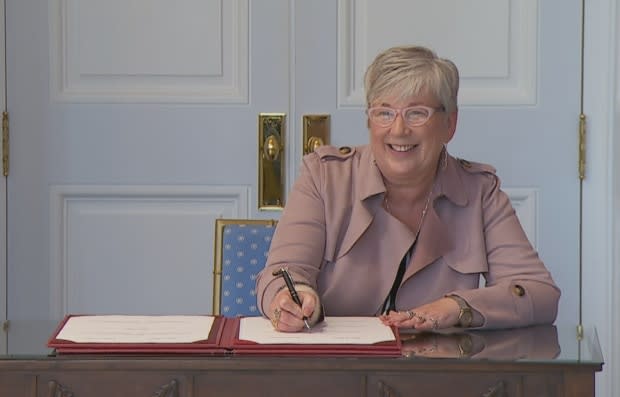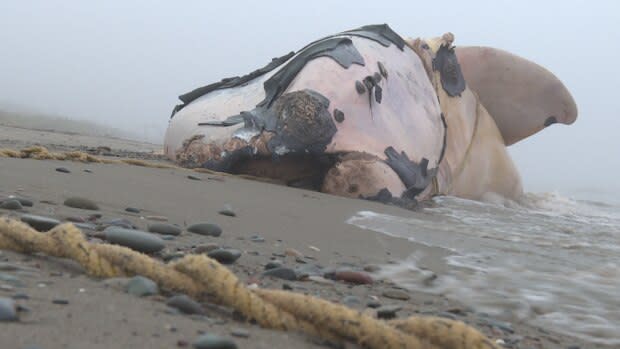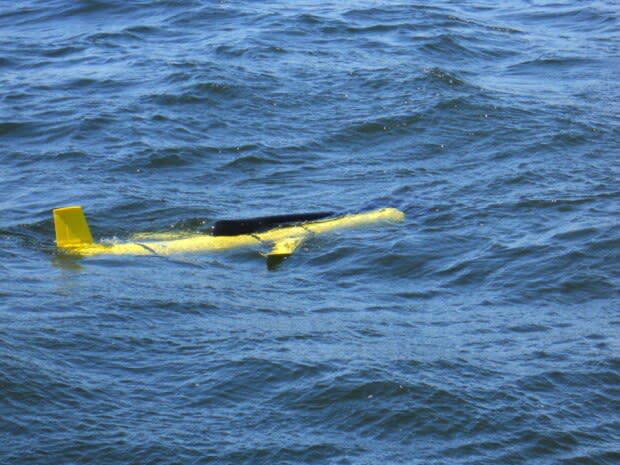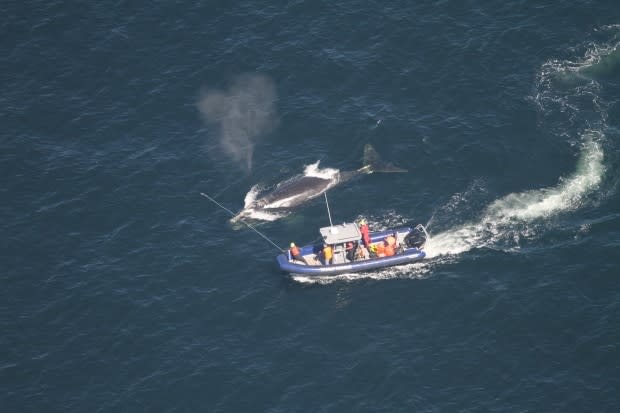Season-long fishing closures possible under new protections for endangered whales

Further measures have been announced to better protect the endangered North Atlantic right whale, after eight confirmed whale deaths in Canadian waters during last year's fishing season.
The federal government has already taken protective steps, such as reducing boat/vessel speeds and altering fishing season dates in the Gulf of St. Lawrence.
On Thursday, the Department of Fisheries and Oceans announced more protections in an effort to prevent future entanglements.
"These new measures build on that work, and are informed by the latest research and technology," said Federal Fisheries Minister Bernadette Jordan in a release.
"We recognize that they are only possible because of the hard work and cooperation of our fish harvesters who have been changing their operations to support our shared goal of protecting this beautiful animal for generations to come."

This year, from April to November, Fisheries and Oceans Canada will be closing fishing in areas of the gulf where whales are gathering in large numbers.
If whales are detected in an area of the gulf more than once during a 15-day period, that fishing zone will be closed for fishing until the end of the season on Nov.15. Previously, the zone would be re-opened after 15 days.
"This means, if a single whale is detected by aerial monitoring or underwater acoustics, a protective area around it of approximately 2,000 square kilometres. or about the size of Ottawa will be closed off," explained Jordan during a press conference.
"Fish harvesters must remove their fixed gear from the area for a 15 day period. If a whale is detected in that area again during that 15 day period, grids within it will be closed to fishing until November 15th."
Temporary fishing closures will also expand further into the Bay of Fundy.
Speed restrictions put in place last season will carry over this year, limiting the mandatory speed limit in the western part of the Gulf of St Lawrence to 10 knots.
All speed and closure restrictions apply to vessels longer than 13 metres. Failure to comply with the restrictions could result in a penalty of up to $25,000.
WATCH: The federal government announced new measures to better protect endangered North Atlantic right whales.
Regional, seasonal changes
The federal government will also be introducing new restrictions in parts of northern New Brunswick and Cape Breton.
This year, there will be a restricted area in the Shediac Valley Area of Interest, a stretch of water about halfway between Lameque Island and Prince Edward Island, which vessels will have to either avoid completely or reduce their speed to eight knots.

In the Cabot Strait between Nova Scotia and Newfoundland and Labrador, a new speed restriction of 10 knots will be tested out for parts of the season.
"That's something completely new," said Transport Minister Marc Garneau during a press conference Thursday.
"Of course, all the whales have to come through the Cabot Strait at the beginning or at the end of the season, so this is something that's going to give us a lot of important area information."
Ottawa also announced a new ice-breaking contract which would open fishing harbours in northern New Brunswick —Acadian Peninsula, Baie des Chaleurs and Northumberland Strait — earlier in the spring, before the whales' arrival in the gulf.
This will ensure the snow crab fishery in the region can get started as early as possible and hopefully avoid contact with the whales altogether.
New gear requirements
Fisheries will be required to mark their gear this year to identify the country, region and fishery it was used in, in an effort to help trace the gear after an entanglement.
The department will also be testing out ropeless fishing gear in closed trials.
The government will also be using new technology to better monitor the presence of right whales this season, including aerial drones and an underwater acoustic glider.
Underwater microphones (hydrophones) will also be used to detect whales in certain areas.
Garneau says they've been testing the use of drones for the past two years.
Will it be enough?
When asked if the new restrictions will be enough to satisfy the United States, who have recently threatened to put an embargo on Canadian seafood imports, Jordan says she's confident it will.
"We know the measures we've put in place are very similar to what they have in the US and we continue to work hard with them to make sure we can keep access to the export market," she said.
Jordan will be meeting with U.S. counterparts in Boston in the next few weeks to discuss the changes.
Activist group Oceana Canada says, while they're happy to see some of the changes they've been advocating for—such as speed limitations in the Cabot Strait and more monitoring—there is still more to be done.
"The challenge always is we don't know what's going to be successful...until the season begins," said campaign director Kim Elmslie.
Elmslie says the group would like to see speed restrictions in the Cabot Strait be mandatory instead of voluntary.
She also would like to see more whale surveillance done by the government.
"What more is going to be done so that we have as many eyes on the water...as possible?" she said.

She says Canada's biggest success in all of this has been its ability to adapt to new whale sightings, which is something she hopes will continue to grow in strength this year.
Elmslie says we'll have to wait and see if the changes will be enough to satisfy U.S. officials.
"The whales don't recognize the boundaries. It's a species on the brink of extinction, so we all need to do as much as we can. The industry on both sides of the border, the government on both sides of the border...we're all in this together."
Population flux
The North Atlantic right whale population stands at around 400, with fewer than 100 breeding females left.
In the Gulf of St. Lawrence, around 130 different whales were identified in the past two years, but Fisheries and Oceans Canada said that's likely an underestimate of true population numbers in the gulf. The government believes those numbers are closer to 200.
Since 2017, 29 right whales have been killed in Canadian waters, largely through collisions with boats or entanglement in fishing gear.

Last year, there were 9 reported right whale fatalities, but one could not be relocated in time for an autopsy.
In 2017 alone, 17 right whales died, sparking a national outcry.
This year, researchers have already spotted 10 right whale calves.
Three calves were spotted off the coasts of Georgia and Florida earlier this month, bringing the total number of endangered right whales born this year above last year's total.
During 2019, only seven newborns were spotted, and none were seen in 2018.
The last time the number of North Atlantic right whale calves surpassed 10 was in 2016, when 14 calves were spotted.


